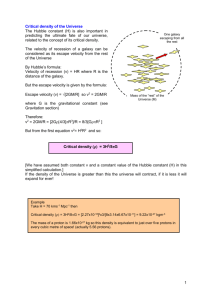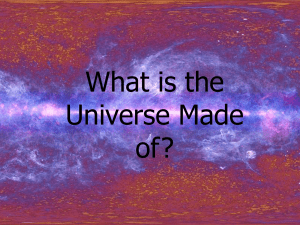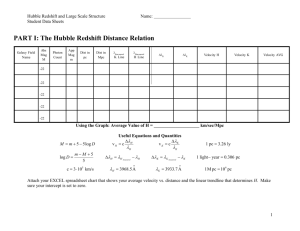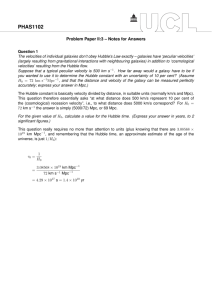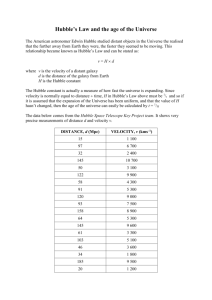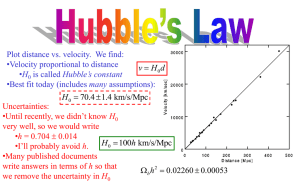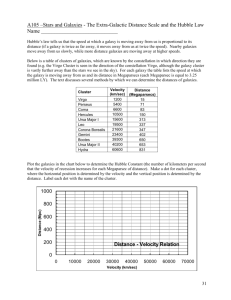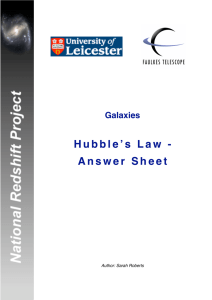ASTR 1010 – Fall 2014 – Prof. Magnani Answer Key – Homework 4
advertisement
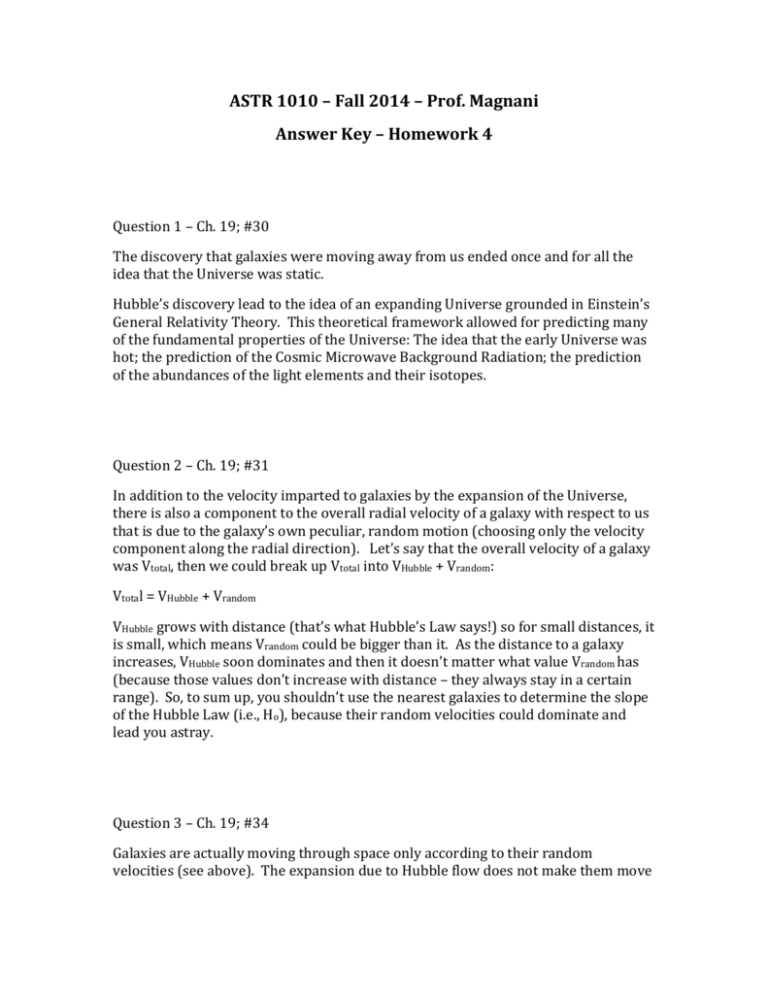
ASTR 1010 – Fall 2014 – Prof. Magnani Answer Key – Homework 4 Question 1 – Ch. 19; #30 The discovery that galaxies were moving away from us ended once and for all the idea that the Universe was static. Hubble’s discovery lead to the idea of an expanding Universe grounded in Einstein’s General Relativity Theory. This theoretical framework allowed for predicting many of the fundamental properties of the Universe: The idea that the early Universe was hot; the prediction of the Cosmic Microwave Background Radiation; the prediction of the abundances of the light elements and their isotopes. Question 2 – Ch. 19; #31 In addition to the velocity imparted to galaxies by the expansion of the Universe, there is also a component to the overall radial velocity of a galaxy with respect to us that is due to the galaxy’s own peculiar, random motion (choosing only the velocity component along the radial direction). Let’s say that the overall velocity of a galaxy was Vtotal, then we could break up Vtotal into VHubble + Vrandom: Vtotal = VHubble + Vrandom VHubble grows with distance (that’s what Hubble’s Law says!) so for small distances, it is small, which means Vrandom could be bigger than it. As the distance to a galaxy increases, VHubble soon dominates and then it doesn’t matter what value Vrandom has (because those values don’t increase with distance – they always stay in a certain range). So, to sum up, you shouldn’t use the nearest galaxies to determine the slope of the Hubble Law (i.e., Ho), because their random velocities could dominate and lead you astray. Question 3 – Ch. 19; #34 Galaxies are actually moving through space only according to their random velocities (see above). The expansion due to Hubble flow does not make them move through space, but it is space itself that is increasing and increasing the overall separation between them. Question 4 – Ch. 19; #36 Relativistic effects change the Doppler relation (equation at bottom of page 135 in textbook) to something more complicated that we don’t want to get into. This change in the Doppler relation, in turn, changes the linear relation between v and z that was derived in the box on page 587 of the textbook. Question 5 – Ch. 19; #37 Standard or “classical” Big Bang Theory predicts that the hot early Universe went from an opaque to a transparent state when the hot plasma became neutral around the 400,000 year mark (we called this the Epoch of Recombination). A hot dense plasma is an excellent approximation to a blackbody, and thus should emit a blackbody or Planck spectrum. So, if the theory is right, the CMBR should have this spectral distribution – and it does. Question 6 – Ch. 19; #38 The tiny brightness variations in the CMBR reveal variations in the distribution of matter (because of a coupling between the photons of the CMBR and mass – your book ascribes the coupling to a type of gravitational redshift, but that’s only part of the reason the photons and mass are coupled together). The bottom line is these brightness (or temperature – remember Wien’s law!) fluctuations tell you about how matter fluctuated in density. In other, words, they tell you about how matter was clumped. It was these clumps which eventually led to clusters of galaxies and thus to the structure of the Universe. Question 7 – Ch. 19; #39 The observed abundances of the light elements in the early Universe tell you something about how quickly the Universe was cooling. This, in turn, tells you how many protons and neutrons you have, and this, in turn, tells you how what fraction of the matter can be in normal or baryonic form and what fraction must be in the form of exotic or dark matter. Question 8 – Ch. 19; #44 Convert 70 km/s/Mpc to 70 km/s / 1 x 106 pc Convert that to km/s / km: 70 km/s / [1 x 106 pc x 3.09 x 1013 km/pc] = 70 km/s / 3.09 x 1019 km = 2.27 x 10-18 s-1 now, take the inverse of that to get the lifetime of the Universe (if it was expanding at constant rate): 4.41 x 1017 seconds = 1.40 x 1010 years or 14.0 billion years. If you repeat the calculation with 75 km/s/Mpc, you will get an age of 13.0 billion years. This highlights the need to get a good estimate of the Hubble constant. Question 9 – Ch. 19; #47 To get the redshift, you need to know the recessional velocity of the galaxy. To get its velocity you use the relation: (lambda_o – lambda_e)/lambda_e = vr/c where “o” means observed and “e” means emitted. You can assume that the rest wavelength and the emitted wavelength mean the same thing in this case. So, (750 nm – 656.28 nm)/656.28 nm = vr/ 3 x 105 km/s Solving for v, you get vr = 4.3 x 104 km/s Since the redshift is related to the recessional velocity by vr = cz we can solve for z: z = vr/c = 0.14 Now, use Hubble’s Law to get the distance: v = Hod d = 4.3 x 104 km/s / 70 km/s/Mpc = 614 Mpc Question 10 – Ch. 19; #50 Wien’s Law says that lambda_max = 0.0029 / T with lambda measured in meters. So, if T = 2.73 K lambda_max = 0.00106 meters this would be 1.06 mm or 1060 microns
